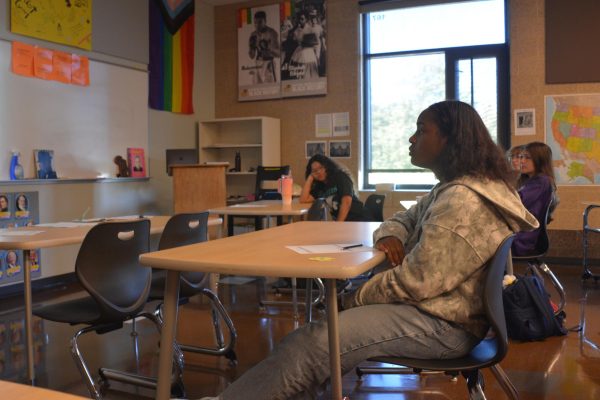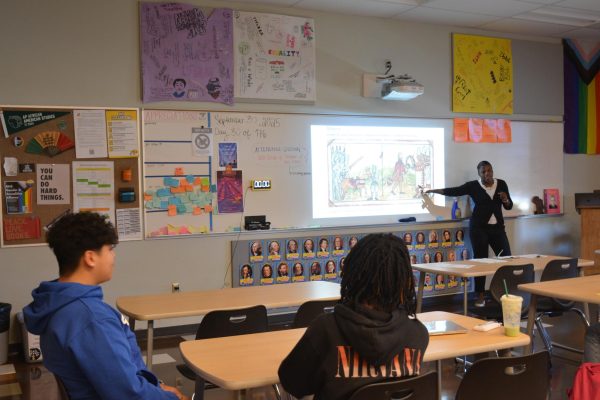Math Department Implements New Curriculum to Align With Common Core
When classes started this fall, students were quick to recognize changes to the math curriculum in honors and college preparatory algebra I, II and geometry courses.
In order to explain the changes to the program, the math department invited parents to a meeting in the community room on the evening of Sept. 6.
With approximately 65 parents in attendance, math teachers detailed what the first day of class looked like for geometry students. Groups of four parents were asked to complete an activity to determine the different lines of symmetry of a square. After demonstrating the ability to create four different patterns, one parent acted as the “recorder reporter” to present what his team learned to the entire “class.”
After this activity, parents listened to an informational presentation regarding the math program.
Math department chairperson Carole Katz explained that these changes were made in order to align more closely to the new Common Core State Standards (CCSS) adopted by 45 states, including Ohio.
While many choices existed to make this transition, the school board and math department adopted the College Preparatory Mathematics (CPM) program, a non-profit mathematics program designed by teachers and released in 1989. This program has been adopted by nearby districts such as Chagrin Falls, Hudson, Kenston, Parma and Solon.
Math department members felt that CPM was the program best-supported by research to expand student knowledge and long-term retention of information.
Algebra teacher Jessica Kellogg, who now uses CPM in one of her courses, is positive about the program.
“Long-term retention is better with CPM,” she said.
Kellogg notes that the goal of the CPM program is that students should not have to study additionally for the final, but she notes that they probably should study for it nonetheless.
At the informational presentation to parents, middle school math teacher Michelle Karim explained that the central idea behind the program is to make Beachwood graduates better math students and better students overall.
The most obvious change to the program is a focus on group learning. According to Kellogg, participants spend the majority of time in groups, each having one specific task. This type of learning allows students to improve communication skills and also requires them to think, reason and share ideas with other students.
According to the presentation on Sept. 6, initial pairings were either randomly-selected or based on a teacher’s judgment of what groups would work best.
Kellogg notes that when students are able to pick at least one person, “they don’t pick a buddy. [Instead they] pick someone they can get along with and do well.”
Another change is a department-wide decision to weight grades based on types of assignments. Assessments represent the largest approximate percentages, accounting for 60% in algebra I, 65% in geometry, and 70% in algebra II. Next, homework and class work represents 25%, 20% and 15%. Assignments represent 15% of each class.
Students also noticed a shift to a technology-driven classroom. E-books are now being used in all CPM programs, which “work well with chromebooks,” according to Beachwood Director of Curriculum and Technology Ken Veon. Homework assistance is also online for student or parent access.
The transition has not been without challenges.
According to Kellogg, the Common Core Standards are fewer in number than the old state standards, emphasizing depth over breadth. She feels that Beachwood is continuing to teach beyond the standards, and that students are adjusting to working in groups.
According to Karim, all of these changes result in a shift in the role a math teacher plays in the classroom. There will be fewer lectures, and teachers will be freed-up to “clarify instructions,” check for understanding, analyze test results, question methodology and provide closure to the lessons on a more individual basis.
“I think working in groups is beneficial to bounce ideas off each other, but every student works and comprehends math at a different pace, creating dividers in the group and making it hard for each student to learn and grow individually,” said Anna Post, a student in Honors Algebra II.
“If people are listening then it works, but if people ignore the teacher and the lesson, then it does not work,” said Daniel Mascia, a student in Honors Geometry.
After listening to the presentation, School Board member and Beachwood parent Steve Rosen said, “Beachwood graduates will be better able to succeed at college and more aligned with Common Core standards.”












